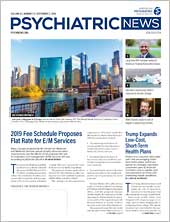There may be times in your practice when you have a patient who expresses violence toward others or when you may be concerned that a patient has the potential to commit a violent act. Given some of the large-scale violent incidents that have occurred, I thought it would be important to outline some of the major issues to consider when treating patients who are or may be violent.
If your patient expresses that he or she wants to harm others, you may need to
consider your duty to warn. If able, first obtain advice on whether disclosure would be permissible under the circumstances notwithstanding your patient confidentiality obligations. However, you may have an extremely urgent issue arise. It is always best to err on the side of caution and safety versus maintaining patient confidentiality.
The best strategy to minimize risk is to document your risk assessment thoroughly. Additionally, APA’s Resource Document on Psychiatric Violent Risk Assessment may be helpful in assessing risk. Briefly, your risk assessment should include documentation of the following:
•
Specific threats (imminent or not).
•
Ability to follow through.
•
Thought process on hospitalization.
•
Why hospitalization is recommended or not.
•
When indicated, discussion with family members or significant others.
If your patient engages in a high-profile violent act, it is preferable not to communicate with others. Your inclination may be to talk with other treatment providers, family members, or even the media. However, prior to doing so, obtain advice on steps to take to ensure you are in compliance with state law in maintaining patient confidentiality.
When a patient has a history of expressing homicidal ideation or has been violent previously, you should document, in every subsequent session, whether the patient admits or denies homicidal ideation. When the patient expresses homicidal ideation, document what he/she expressed and the steps you did or did not take in response and why. Should an incident occur, your documentation will play an important role in defending your actions.
Despite taking precautions, your patient may still commit a violent act. The following are some strategies that may minimize your risk.
•
Conduct complete timely/thorough risk assessments.
•
Document, including the reasons for taking and not taking certain actions.
•
Understand your state’s law on duty to warn. Be aware of the language in the law on whether you have a mandatory, permissive, or no duty to warn/protect.
•
Understand your state’s laws regarding civil commitment.
•
Understand your state’s laws regarding disclosure of confidential information and when you can do so.
•
Understand your state’s laws regarding discussing firearms ownership and/or possession with patients.
•
If you have questions, consult an attorney or risk management professional.
This information is provided as a risk management resource for Allied World policyholders and should not be construed as legal or clinical advice. This material may not be reproduced or distributed without the express, written permission of Allied World Assurance Company Holdings, GmbH, a Fairfax company (“Allied World”). Risk management services are provided by or arranged through AWAC Services Company, a member company of Allied World. ■
This information is provided as a risk management resource for Allied World policyholders and should not be construed as legal or clinical advice. This material may not be reproduced or distributed without the express, written permission of Allied World Assurance Company Holdings, GmbH, a Fairfax company (“Allied World”). Risk management services are provided by or arranged through AWAC Services Company, a member company of Allied World.
APA’s Resource Document on Psychiatric Violence Risk Assessment can be accessed
here.

